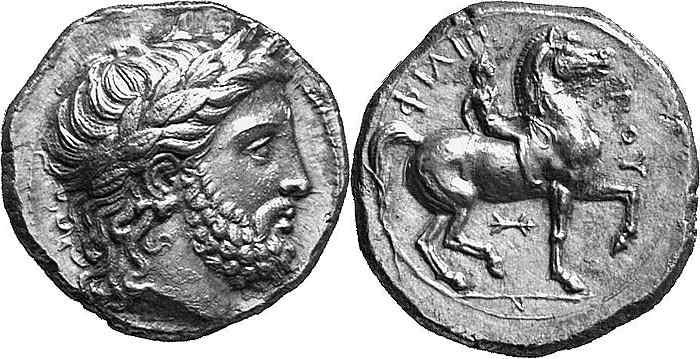H 113 - Pella (Alexander the Great), silver, tetradrachms (323-315 BCE)
From SILVER
323 BCE - 315 BCE Silver 9,156 kg
Description
| ObverseInscription or printing placed on the obverse.: | Head of Zeus right, wearing laurel wreath. Border of dots. |
| ReverseInscription or printing placed on the reverse.: | ΦΙΛΙΠΠΟΥ (Greek).Nude jockey on horseback to right, holding long palm branch in his right hand, below horse, horizontal thunderbolt, in exergue. |
Mint and issuing power
| MintIdentifies the place of manufacture or issue of a numismatic object.: | Pella | Ancient regionAncient region.: | Macedon | Modern countryModern country: Greece | AuthorityIdentifies the issuing power. The authority can be "pretended" when the name or the portrait of X is on the coin but he/she was not the issuing power. It can also be "uncertain" when there is no mention of X on the coin but he/she was the issuing power according to the historical sources: | Philip II (Argead king, 359-336 BC), Alexander III the Great (Argead king, 336-323 BC), Macedonian kingdom |
Chronology
| FromIdentifies the initial date in a range assigned in a numismatic context. | 323 BCE | toIdentifies the final date in a range assigned in a numismatic context.. | 315 BCE | PeriodTime period of the numismatic object.: Hellenistic 323-30 BC |
Physical description
| MetalThe physical material (usually metal) from which an object is made.: | Silver |
Median weightMedian of the weights of numismatic objects (in grams). in grams | 14.40 | DenominationTerm indicating the value of a numismatic object. Examples: tetradrachm, chalkous, denarius.: | tetradrachm |
StandardStandard.: |
Image

H113 Zeus Pella.jpeg [1]
References
| Die study referencePublication of the study: | Le Rider 19771Le Rider 1977 | ||
| Coin series referenceReference to coin series study: | RQEMH2RQEMH, n° 113 | ||
Obverse dies distribution
| FrequencyFrequency of specimen in distribution. ᵖ | Number of obversesNumber of obverse dies. ᵖ (o) | % (o) | Number of coinsNumber of coins. (n) | % (n) | Die nameName(s) of the die(s). |
| 1 | 6 | 20.69 | 6 | 3.85 | 232, 245, 268, 274, 276, 277 |
| 2 | 5 | 17.24 | 10 | 6.41 | 234, 244, 266, 269, 275 |
| 3 | 1 | 3.45 | 3 | 1.92 | 271 |
| 4 | 2 | 6.9 | 8 | 5.13 | 246, 267 |
| 5 | 3 | 10.34 | 15 | 9.62 | 242, 270, 273 |
| 6 | 1 | 3.45 | 6 | 3.85 | 280 |
| 7 | 1 | 3.45 | 7 | 4.49 | 279 |
| 8 | 3 | 10.34 | 24 | 15.38 | 230, 233, 243 |
| 9 | 3 | 10.34 | 27 | 17.31 | 235, 259, 282 |
| 10 | 1 | 3.45 | 10 | 6.41 | 231 |
| 11 | 2 | 6.9 | 22 | 14.1 | 272, 278 |
| 18 | 1 | 3.45 | 18 | 11.54 | 281 |
| Total | 29 of 29 | 100 | 156 of 156 | 100.01 |
Reverse dies distribution
no distribution is available
Quantification
| Number of obversesNumber of obverse dies. ᵖ (o) | 29 | Number of singletons (o1)The number of singleton coins. ᵖ | 6 |
| Number of reverse diesNumber of reverse dies. (r) | 63 | Number of coinsNumber of coins. (n) | 156 |
| Coins per obverse dieNumber of coins per obverse die. (n/o) | 5.38 | Coins per reverse dieNumber of coins per reverse die. (n/r) | 2.48 |
| Reverse per obverse ratioRatio of obverse dies divided by reverse dies. (r/o) | 2.17 | Percentage of singletons (o1)number of coins (n) divided by the number of singletons (o1) ᵖ | 20.69 % |
| Original number of dies (O) (Carter 1983 formula)The estimation of the number of coins according to Carter 1983 ᵖ | 31.79 | Coins struck if 20,000 as average productivity per dieCoins made if the average productivity for obverses (according to Carter) is 20,000. ᵖ | 635,800 |
| Original number of dies (O) (Esty 2011 formula)The estimation of the number of coins according to the singleton formula in Esty 2011 ᵖ (O) | 35.62 | Survival rate if 20,000 as average productivity per dieSurvival rate if average productivity is 20,000. ᵖ | 0.00025 |
| Coverage (o = % of O) (Esty 1984 formula)Esty 1984 - coverage (% of O) ᵖ (o = % of O) | 96.15% | Die productivity if survival rate 1/2,000Average productivity if survival rate is 1/2,000. ᵖ | 9,814.41 |
| Weight of silver (in kg) if 20,000 coins per die (O = Carter formula)Carter 1983 * Median weight * 20000 (*10 if gold or electrum) ᵖ | 9,156 kg <br /> 9,156 kg | Die productivity if survival rate 1/5,000Average productivity if survival rate is 1/5,000. ᵖ | 24,536.02 |
Remarks
Most likely one single workstation